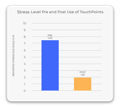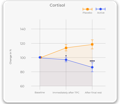The Science Behind TouchPoints


Stress impacts us both physically and mentally, taking a toll on our focus, sleep, performance and general ability to cope. Chronic stress can lead to heart disease, heart attack, high blood pressure, and stroke. Unfortunately, according to the American Institute of Stress, 77% of people experience stress that affects their physical health.
The problem is our body reacts to minor stress the same way it does to serious danger, activating our “fight or flight” response and triggering stress hormones like adrenaline and cortisol, making us feel anxious and out of control. But our default stress reaction can literally be rewired with TouchPoints.
Developed over several decades by a team of neuropsychologists, TouchPoints use gentle, alternating vibrations to modify your response to stress, rapidly shifting your “fight or flight” response to a more serene, balanced state and putting you back in control. You simply place TouchPoints on either side of your body – in pockets, socks, on straps, your belt, wristbands or even held in your hands – and begin to feel calmer in seconds.

Quantitative Electroencephalogram Data
Our study involving quantitative electroencephalogram data clearly shows a reduction in brain wave activity in areas associated with anxiety (beta waves). TouchPoints’ patented BLAST (bi-lateral alternating stimulation-tactile technology) alters the body’s “fight or flight” response caused by stress. The wearables emit vibrations that disengage your standard stress response which can impact your performance and health.
And the results have shown to be life changing. This unique process of shifting from one brain area to another has been proven to create new behavior patterns that lessen your reaction to stress over time.


Research-Proven measurable impact
74% Reduction in Stress in 30 Seconds
The data showed that within just 30 seconds of using TouchPoints, people experienced a 74% reduce in their stress levels and a 68% reduction in body sensations related to stress. This data combined with our archived data suggest that there is a consistency in offering users significant relief from physiological and psychological stress in about 30 seconds. View our full Stress Study.
Effect Of Bilateral Alternating Somatosensory Stimulation On Reducing Stress-Related Cortisol
This triple blind placebo-controlled trial with athletes showed TouchPoints stabilized cortisol levels during stressful events and reduced the level of stress points even when cortisol traditionally spikes.

ACADEMIC Studies
EMDR Bilateral saccadic eye movements and tactile stimulation,but not auditory
stimulation, enhance memory retrieval
PTSD Eye Movement Desensitization and Reprocessing for Posttraumatic Stress Disorder
PTSD Applied Bi-Lateral Alternating Stimulation - Tactile (BLAST) As a Stress Inhibitor Amy Serin, PhD.
TACTILE STIMULATION The Cerebellum Contributes to Somatosensory Cortical Activity during Self-Produced Tactile Stimulation
TACTILE STIMULATION Empathy for Pain and Touch in the Human Somatosensory Cortex